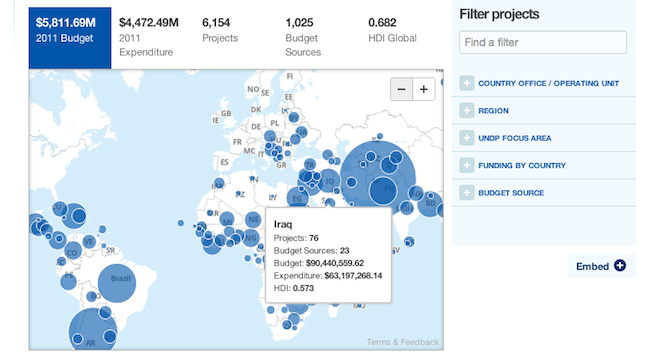As one U.N. agency takes flak for its perceived threats to the open Internet, another is actually using the Web to provide further transparency on its activities.
The United Nations Development Programme (UNDP), the arm of the UN established in 1965 to help build up nations around the globe — which it now aims to do by reducing poverty, encouraging democratic participation and empowering women — on Thursday launched a new website, “Open.UNDP.org” showing exactly where and how it is spending the entirety of its $5.8 billion annual budget for 2011 around the globe.
The website offers interactive views, allowing users to hover over a world map to see the size of different expenditures per country, and offers filters to see expenditures by country, region or project type, among other tools. It also has a handy embed feature, as seen below:
“‘Open data’ has been a buzzword for the past couple years,” said Mark Cardwell, the UNDP’s online communications chief, in a phone interview with TPM. “But it’s not good enough to just put up an ‘Excel’ file or another piece of machine-readable data or a year-end report. We want people to look at this and immediately be able to understand what we’re doing.”
For the project, UNDP partnered with Development Seed, a Washington, D.C.-based data visualization company committed to open source access that began in 2003. UNDP turned over its data to Development Seed, which constructed the resulting website to be “the most powerful and fastest project browser we have ever built,” as Development Seed’s lead developer Matt Greene explained in a blog post on Thursday.
The two organizations were in some ways a natural fit, as UNDP promotes its “long-standing commitment to transparency.” As such, Cardwell noted that the new website was just one of the UNDP’s open data initiatives.
“The organization is embracing this wholeheartedly across all levels,” Cardwell said of open data. “This particularly project is not even halfway there, and we have other projects moving within the organization.”
But publicizing data about aid workers and projects around the world isn’t entirely without risk, as UNDP’s Cardwell acknowledged.
“We wrestle with how to ensure security all the time,” Cardwell said. “If people are working in a country with a security risk, we may take out people’s names or anonymize them. We never talk about the movements of our staff and never list addresses. But you can email just about every one of our project leaders. If you wan’t to send an email to the guy that runs our Afghanistan office, you can do it, and that’s probably the highest security level operation.”
The UNDP counts over 7,000 staff members across the globe, and another 7,000 roving consultants. All of their projects, with the exception of what Cardwell said the UNDP refers to as “management projects” — buying office supplies for the agency’s headquarters in New York, for example — will show up on the new Open.UNDP.org website.
And although Cardwell said his team still had a number of features left it wanted to implement on the new Open.UNDP.org website in 2013 — including more fully automized data updates and more reliable communication channels for its workers, such as sending SMS messages to Twitter feeds — he was pleased with the newly available and more user-friendly information.
“The classic example is Haiti,” Carwell said. “You’ve got over 1,000 NGOs [non-governmental organizations] on the ground and nobody knows what’s going on. This allows you to know more.”






